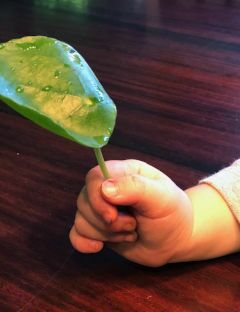Good Fortune by Way of the Chinese Money Plant
Ahem, I must clear the air…. Well actually, I already have, with a plant.
In general, houseplants bolster health in the home. But some are truly renowned for their air purification capabilities. Pilea peperomioides, commonly known as the Chinese Money Plant, is one of these highly attractive and natural air purifiers.
I was drawn to Pilea peperomioides plants for their coin-shaped leaves and because they are believed by many to spread good luck. Never before have I seen perfect disk-shaped leaves atop stems that seem hardly able to support such sizable “coins” and to do so as if skinny, strong arms are balancing circular platters with absolute skill.
Some of the “coins” on the Chinese Money Plant sit perfectly horizontal atop their stems. Others face out, with the slight bend of a stem or two. And still others that are present on my plants are tiny babies, ready to grow as both my luck and my wealth do the same. (Fingers crossed.)
When I first heard of Money Plants, my mind went immediately to Lunaria, commonly known as Honesty, which I remember outside my childhood home. Those plants which I knew as Silver Dollar Plants showed their beauty best in autumn. That was when their green-clad seed pods would dry up, and adult hands could rub off the dry husks to show a young gardener and her friends the shiny, film-thin coins that emerged for use in indoor arrangements.
But despite my love of this memory, I learned over time that Silver Dollar Plants are unsuitable for growing indoors. The Chinese Money Plant can be used indoors with ease. And its beauty draws in the human eye at all points in the year.
Pilea peperomioides are used a great deal by those who practice Feng Shui. And their geometric effect—disks of different sizes, which look at first glance to be suspended in air—is attractive for all who care to add living green to interior décor. In adding to the attractiveness of my indoor space, the Chinese Money Plant is of great value—pun intended.
Young children can get to know indoor gardening by working with these easy and forgiving green specimens. (I have included a brief video to show just how forgiving these plants are.) Pilea peperomioides are stronger than they look, stay a rich and healthy green, and have a smooth sheen to their leaves that can be maintained with nothing more than periodic dusting.
 Neophyte Pilea Peperomioides are ideally sized for care from small hands. (See photo for a sense of leaf size.) And they are strong enough to withstand more than a little jostling by young children as they are transplanted. The Chinese Money Plant likes good drainage, and it does not mind drying out slightly between waterings—good for the child of any age who may forget to make regular moisture checks on the plant. It also likes bright, indirect light and just a couple of feedings each spring, and then again in summer, with a well diluted liquid fertilizer.
Neophyte Pilea Peperomioides are ideally sized for care from small hands. (See photo for a sense of leaf size.) And they are strong enough to withstand more than a little jostling by young children as they are transplanted. The Chinese Money Plant likes good drainage, and it does not mind drying out slightly between waterings—good for the child of any age who may forget to make regular moisture checks on the plant. It also likes bright, indirect light and just a couple of feedings each spring, and then again in summer, with a well diluted liquid fertilizer.
With this basic care, baby gardeners can look for baby plants—offshoot Pilea peperomioides that can be propagated by cutting them apart from the main plant and positioning them in water until new roots form. The offshoots can also be placed directly into soil, if that is more manageable. Small leaves atop the offshoot Pilea peperomioides plant should sit above the soil, but any large stems and leaves that remain attached to the new plant can be snipped. The propensity of Pilea peperomioides to offer up these smaller plants to the gardener gives this plant its alternate name, Sharing Plant.
Beauty, air purification, multiplying good fortune—the Chinese Money Plant offers numerous gifts to the home of the gardener who takes a moment or two to seek it out. Wishing you all those gifts, I have been waiting to share this plant with you.
Comments
{{ errors.first("comment") }}